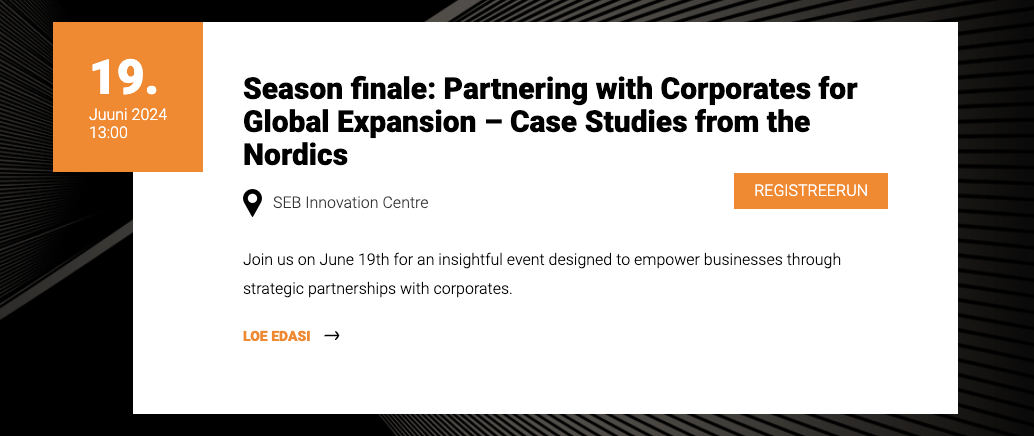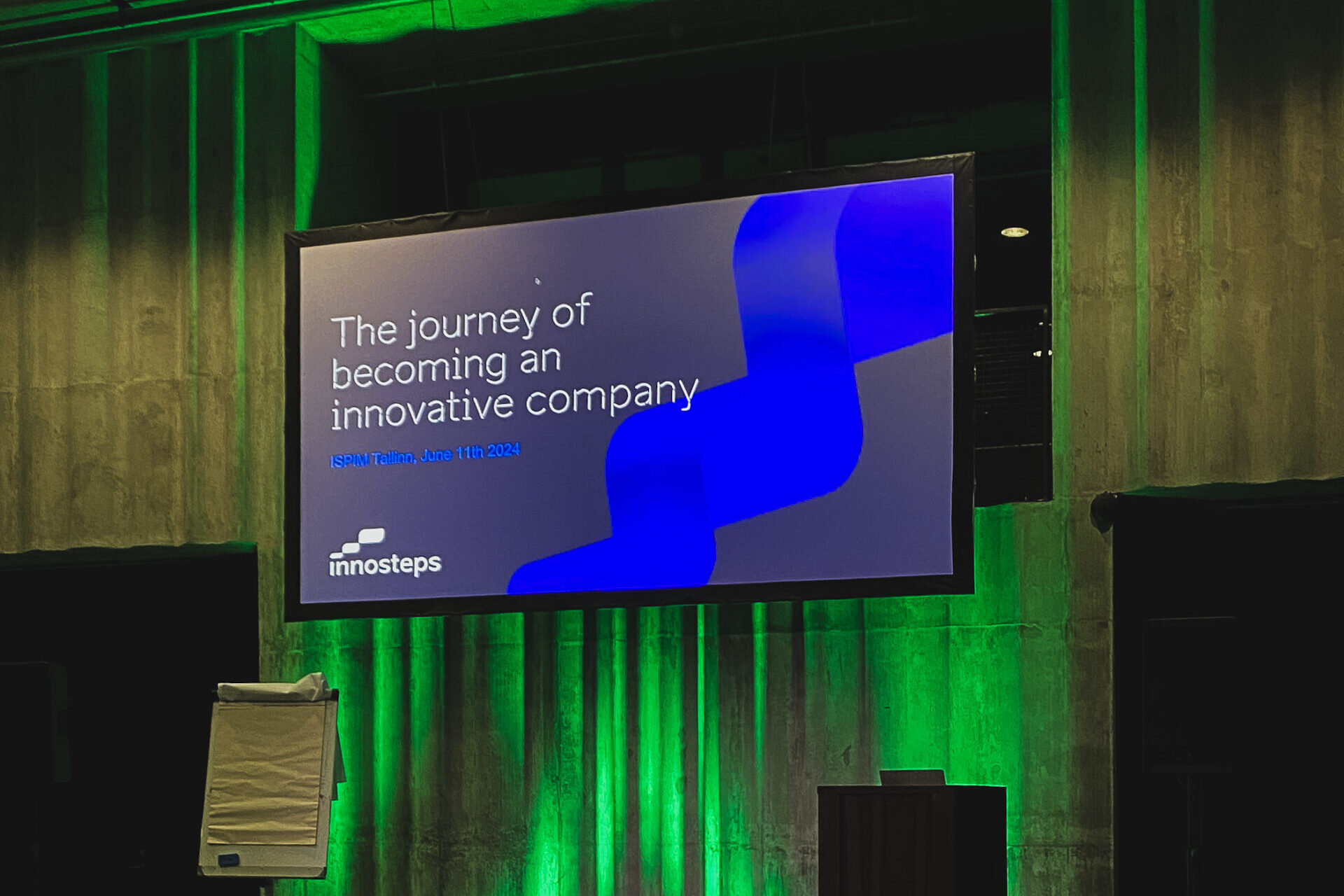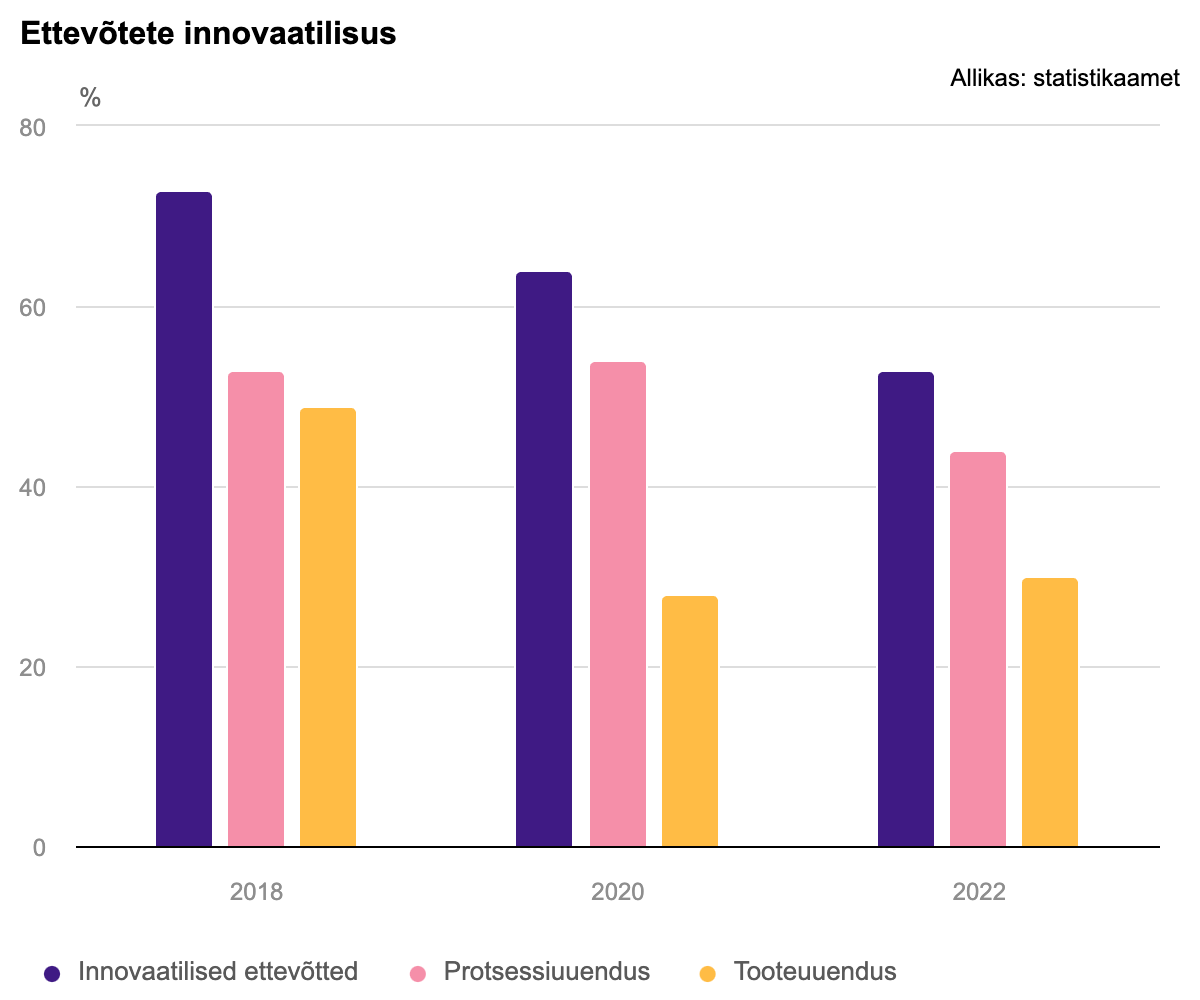Let’s move to a new level together
The Innotrep web environment is a cooperation ecosystem for increasing the innovative capacity of Estonian companies and developing a common culture of innovation.
Three steps to an innovative company
Read more about the processAnalyze and evaluate your company’s innovation capacity
Create an individual action plan to increase your competitiveness
Use the opportunities of the Innotrep network to develop your business
Innotrepp is a model for the development of the innovation capacity of companies, with the help of which we can talk about innovation based on the level of development and needs of each company.
The purpose of innovation is to create value and achieve a competitive advantage, contributing to the company’s development and productivity growth. At the same time, innovations do not always have to be the first in the world or lead to a radical change, but can also contain small incremental changes that improve. Users of the Innotrep application have the opportunity to evaluate their innovation capacity with a simple test and find suitable partners for cooperation.
79
Number of joined companies
Estonian companies interested in innovation, who contribute to the Estonian economy with their growth ambitions
2.1
Average score
The average Estonian company is just like this – shall we rise to the next level together?
Innotrep matrix
The Innotrep matrix looks at the six key drivers of innovation performance at five different levels. To read the matrix, start from the bottom left corner – ambition and leadership – and move upwards. For a more detailed description of each level of a company’s innovation capacity, click on the category to open it!
Inspiration
Basic knowledge
Processes and organisational engagement
RD and investment intensity
Global impact and reach
No internal knowledge, skills or technologies are kept or documented.
The company pays attention to keeping internal knowledge and skills within the company.
The company has procedures in place to avoid uncontrolled disclosure of internal knowledge, know-how and technologies and to protect trade secrets/intellectual property.
The company has procedures and experience to create knowledge or technologies in collaboration with other companies. The company is prepared to license some foreground and technologies to non-rival companies.
The company’s intellectual property is commercialised in a systematic way, for example through licensing or the creation of spin-off companies.
We do not collaborate with other companies or organisations on innovation activities, but we do gather information from the market about trends in our field.
We do a small amount of innovation with customers, partners and/or suppliers.
We have well-established partnerships and innovation projects with selected partners to develop new products and services.
We have a systematic and continuous innovation partnership with businesses, researchers, customers and professional networks.
Innovation cooperation works through an open collaboration platform, through which we seek the best market knowledge and partners.
We are not investing consciously in innovation. Our budget does not differentiate between innovation activities.
Our budget includes funds for innovation projects, but innovation spending is ad hoc, mainly responding to market conditions, and innovation spending is not differentiated.
We have implemented a fixed budget for innovation projects, including continuous automation and digitisation, and we have processes in place to finance these projects.
We devote a significant part of our budget to innovation. Investment is focused on research and development (around 2% of turnover or more than €1 million).
Our financial planning is fully integrated with our innovation strategy, allowing us to be a leader in the field and set the direction. The focus of investment is on research and development (around 10% or more of turnover or in millions of euros).
The capacity to raise money is currently lacking or inadequate.
We have a small number of innovation projects funded on a project basis.
We have systematic investment in innovation and the capacity to finance innovation on a consistent basis.
We have put in place a strategy to finance innovation projects and have the capacity to attract external investment and funding.
We have a wide and diverse range of funding sources for innovation, including for example internal funds, venture capital and/or grant schemes, and the capacity to raise money through a stock exchange listing, where appropriate.
We do not have the knowledge or experience of managing innovation processes, nor do we have established innovation governance principles. When an idea for innovation arises, it is implemented on the side. Innovation activities tend to be haphazard, they are not systematically planned, and the generation and implementation of ideas is random.
Innovation activities are needs-based. Innovation activities are project-driven and may involve new products, services, processes, business models or technologies. The company has some initial knowledge of how to manage innovation processes and may have started by describing processes. However, innovation is still being implemented on a project-by-project basis, as and when required.
The guiding principles for innovation processes are in place but partially implemented. The company has established and managed innovation processes to implement innovative ideas. An innovation guiding principle is a set of instructions, guidelines, policies or rules formally adopted and established by a company that governs how the company plans, manages and promotes innovation in its operations and strategies. It involves the regular generation, evaluation and development of ideas to achieve a continuous and iterative process of innovation. The aim of systematic innovation is to increase the effectiveness of innovation and to ensure that it is embedded in the day-to-day activities of the organisation.
An innovation management system is in place and fully implemented. The company has in place continuously improved processes for innovation management, systematic implementation of innovation projects and risk management. Strategic innovation is implemented, where the company designs and implements new ideas and innovations that support its long-term business objectives and strategy. It focuses on how innovation can help a company to achieve a competitive advantage, expand market share or create new business opportunities. Strategic innovation is deeply embedded in a company’s business plan and long-term vision and is used to achieve strategic objectives.
The company’s innovation management system is of strategic importance and internationally scalable. This means that innovation is not only targeted at the local market, but also at international markets and often requires the development of an international business strategy and careful planning of resources and partnerships. The innovation management system is in line with the ISO 56002 standard for innovation management, and is also used in the partner network.
The company does not distinguish between traditional development projects and innovation projects. It deals with projects where the risks have been assessed.
Innovation projects are random. The company undertakes renewal projects on a project-by-project basis and/or on an as-needed basis, giving priority to lower risk projects.
A holistic overview of innovation projects. The company owns, differentiates and manages existing innovation projects, at different levels of risk, but may not own projects across all 3 horizons.
Holistic innovation project portfolio management through 3. horizon. The company monitors and manages its innovation projects across the different innovation horizons ( 1 – new to the company, or incremental innovation; 2 – new to the target market and/or its industry; 3 – new globally, or radical innovation) to ensure that they are ready to address both short and long-term challenges and that their innovation supports the overall strategy and business objectives.
The company has segmented innovation portfolios. Innovation projects are categorised into different segments according to specific objectives, needs or market segments. This allows the company to focus on different areas and manage innovation resources more efficiently.
There is no separate process for gathering ideas in the company, the collection of ideas is random. Brainstorming, or the process by which a company collects and collates new ideas and suggestions from employees, partners or customers to find potential innovations or solutions to problems.
Idea generation is driven by market demand and is largely linked to process improvement. Employees have the opportunity to put forward their ideas and suggestions for improvement. It can involve different channels for submitting ideas, such as online platforms, hackathons, workshops or brainstorming campaigns.
Idea gathering to improve processes or products/services takes place at least once a year. From the ideas collected, a selection is made to be tested. Some market testing methodology is used.
The company has developed a regular open call for ideas. Ideas are systematically focused mainly on developing products/services and leveraging competitive advantage. A continuous market testing methodology is applied.
Brainstorming is part of our innovation process and culture. Idea generation, testing and development are an integral part of the innovation management process.
The company does not consciously engage in product or service development.
The company has some experience in product development. Mainly adapting the product/service to customer requirements or creating small-scale modifications.
The company has proprietary products and/or services, which we have created a customer-centric approach and product development process to develop.
The company has an extensive portfolio of proprietary products, for which specific development processes have been developed.
The company has a large-scale product/service development based on open innovation principles. Manage development processes both within the company and in a collaborative network.
There is no clear and distinctive selling point. The business model is business as usual (similar to competitors). No experience of getting to know the customer/consumer and their real needs in order to adapt products/services accordingly.
The business model is constantly being rethought, and there are initial ideas and hypotheses on how the business model could be used to leverage competitive advantage in the future. Real changes to the business model have not yet been implemented. Competitive advantages could be price and efficient business processes. There are some innovative elements in the business model, but these are limited.
The business model is innovative at home and in selected target markets. Systematic renewal of the business model to maintain and/or completely change the current competitive advantage. The ambition is to achieve a clearly differentiated business model.
A business model that is significantly differentiated from its competitors, allowing it to exploit competitive advantages. Often a sector leader. The uniqueness of the company’s business model allows it to enter new markets.
We have a unique business model that has given us a first-to-market advantage. The company’s business model creates entirely new markets where it is the only or one of the few providers.
The company’s technology is at the same level as its competitors in the market. It uses widely available technologies that are ready for use by all market players and do not provide a significant competitive advantage.
The company’s technology has some advantage in selected markets. The use of widely available technologies, adapted to the company’s processes, gives a competitive advantage in the target market.
The company’s technology gives it a significant advantage over competitors in its field. It makes significant use of upgraded technology, which gives it a competitive advantage in its field, irrespective of the region.
The company’s technology allows it to enter markets that are inaccessible to competitors. The use of novel and/or significantly upgraded technology gives the company a competitive advantage irrespective of the region and/or sector.
The company’s technology enables the creation of entirely new markets around the world. Unique technologies are used to create entirely new uses and to transform existing markets.
Product/service prevalent in the market.
A market-enhanced product/service is a product or service that has undergone changes or improvements to better meet market demands or consumer expectations. This can include a variety of improvements such as increasing quality, adding features, changing design, adjusting price or improving service.
A distinctive own product is a product or service that is different from other similar products or services available on the market and offers unique characteristics, benefits or added value to consumers. This differentiation may include particular design, quality, features, brand awareness or other unique characteristics that make the product prominent and attractive on the market.
Internationally distinctive own product/service, recognised brand. The organisation makes consistent efforts to maintain and exploit the value of its brand and to ensure its effective protection and management. This can be an important part of business strategy and competitive advantage in the market.
An open innovation based proprietary product and/or service that is a leader in its product category. Open innovation is an approach where an organisation collaborates with external parties, such as other companies, universities, research institutions, customers or partners to identify, develop and implement new ideas and innovations. It involves sharing ideas and knowledge outside the company, and leveraging knowledge and skills from outside to create value and competitive advantage. Open innovation can include technology transfers, collaborative projects, licensing agreements and other forms of cooperation.
The company’s value proposition is not protected, it tries to develop faster than its competitors. A value proposition is a company’s promise of how its product or service will solve customer problems or meet their needs better than competitors. It helps a company to differentiate itself in the marketplace and to attract customers who feel that they are getting a particular benefit or value from a particular company or product.
The knowledge needed to realise the value proposition is kept as a trade secret. The value proposition may cover different aspects such as the quality of the product/service, the pricing formula, unique features, ease of use, brand reputation or customer service.
The company has partially protected trade secrets and/or some registered intellectual property, but no systematic approach yet. A protected trade secret is a trade secret consisting of information, data, processes or other knowledge that gives a company a competitive advantage because it is not publicly known. Protected trade secrets can include a wide variety of information, such as product recipes, production processes, marketing strategies, customer lists, research and development results or other knowledge that is important to the company.
The company has a portfolio of products protected by intellectual property rights. The intellectual property needed to realise the value proposition is catalogued and actively managed, and the protection of intellectual property through registration is systematised. The IPR portfolio comprises the company’s products, services or technologies that have been granted legal protection through intellectual property rights such as patents, trademarks, copyrights or designs. This protection helps the company to protect the intellectual property it has created and to ensure that no one else can use, copy or distribute it without permission.
The company has a well thought-out IP protection strategy, an actively managed IP portfolio and/or registered industrial property. An IP strategy is a company’s plan for how to protect the intellectual property it has created, such as patents, trademarks, copyrights, designs and trade secrets. The purpose of the protection strategy is to preserve and maximise the value of the intellectual property created, to protect it from unlawful use or misuse, and to give the company a competitive advantage in the marketplace.
Business processes focus on key processes. Organic process improvement, mainly responsive to market conditions.
Some innovation in support and management processes, with the aim of making them more efficient. For example: an action plan for digitisation and automation has been established and partially implemented.
Deliberately implemented systematic digitisation and automation of business processes to achieve competitive advantage.
Innovation-driven systematic and proactive business process improvement and streamlining.
Systematic and strategic continuous business process innovation with performance evaluation.
The company does not consciously analyse the work culture, create or develop a culture that supports innovation. Company culture is the set of organisational values, practices, behaviours and attitudes that determine how people work and interact within an organisation.
The company’s culture of innovation is not well established, but individual innovations can be tested.
A company culture that supports innovation, openness to change and willingness to take risks. The company invests in employee engagement, creativity, motivation and satisfaction. The company has a description of the recommended standards of behaviour and practices within the organisation. This includes the way in which people communicate, lead, collaborate and innovate.
A company’s innovation culture is based on shared values and beliefs. It is open to change and dares to take risks. The company has implemented innovation performance incentives to develop competences.
The company’s innovation culture is characterised by deep-rooted shared values and beliefs, while at the same time fostering creativity and efficiency through collaboration. A horizontal management culture is deliberately developed within the company. Open and honest communication is implemented, which contributes to an understanding of the culture and values of the organisation. The organisation’s core values and beliefs are actively promoted and emphasised.
Employees do not play an active role in innovation. Initiating and adapting to innovations is rather difficult, and employees value stability and daily work.
There are a few innovation leaders in the company who are open to change and willing to take risks. Innovation is a sideline to the core business. Leaders shape and define the values of the organisation and set an example through their behaviour, thereby influencing the attitudes and behaviour of employees. They are also responsible for fostering open communication, teamwork and staff development in line with the organisation’s objectives.
There are positions in the company whose tasks are related to innovation activities. Employees are motivated to think “outside the box” and carry the values of innovation.
The company has a competent team whose main tasks are related to innovation. They work with commitment, create and maintain a culture that supports innovation.
The company recruits in line with the objectives of the company’s innovation strategy, and consciously seeks people with values and skills that support innovation to complement our existing team.
There is no international scalability or the focus is currently mainly on the domestic market. Enquiries from foreign clients are rather occasional.
The company has a few export markets where the product/service fits. The company regularly receives orders from foreign customers but does not actively sell to target markets.
The company has well-established international target markets and products/services to match them. Products/services are tailored to specific target markets. The company has export/sales managers and/or sales partners on the ground in the target markets with a focus on the target markets.
The company has a strong international brand and presence in foreign markets. It is expanding its reach into new markets. Products/services are developed specifically for different target markets. Exports account for a significant share of sales revenue
The company has global sales and business reach. Global scale of business refers to the company’s operations and expansion at an international level, where the company operates in several countries and/or in a large number of markets. The company engages in business activities that are internationally diversified and extensive.
The company has ambitions to be a market leader in the local market.
The company has the ambition to reach selected foreign markets with competition and has chosen specific target markets to match its product/service.
The company has a broader international market leadership ambition and the product/service sales ambition includes market leadership in its region.
The company has global ambitions to conquer markets. The company’s product/service sales ambition includes being a global market leader in its field.
The company has the ambition of a market-changing global collaboration platform and the goal of creating and launching a platform or solution that not only transforms an existing market or industry, but also supports international collaboration and influences global dynamics.
The company reacts to change as and when it is needed and does not plan innovation projects far in advance.
The company has a 1-2 year plan and budgeted ongoing development activities, including upgrading projects.
The company has a 2-5 year plan, which includes systematically managed innovation projects and targets. Innovation projects are planned and managed, following a defined methodology and system to ensure the successful development and implementation of innovation in the organisation in line with strategic objectives.
The company has a 5 to 10-year plan based on vision and knowledge-intensive innovation. Knowledge-intensive innovation requires extensive use and development of knowledge, expertise and intellectual capital. This implies that the successful implementation of innovation depends on a strong knowledge base and specialised skills.
The company has a 10+ development horizon and a strategy based on knowledge-intensive innovation. Knowledge-intensive innovation often involves research and development, where scientists, engineers and specialists develop new technologies, products or services.
The company is keen to invest more in development alongside its current activities.
The company has the willingness to take new initiatives and the desire to better manage innovation processes.
The company has systematically managed innovation projects and the ambition to create an innovation strategy. An innovation strategy is a company’s planned and systematic approach to how they intend to promote, manage and implement innovation in their business.
The company wants to make RD an integral part of its innovation. RD is the process of generating new ideas, technologies, products, services or processes that form the basis of innovation.
The company wants to create innovation projects with a long horizon to create market-changing products/services. Long-term innovation projects may include RD activities to research and develop new technologies, long-term product development to conquer new markets or the creation of new business models that may change the company’s business model in the future.
News
Exciting events and information take place in the Estonian innovation ecosystem. Stay up to date!



